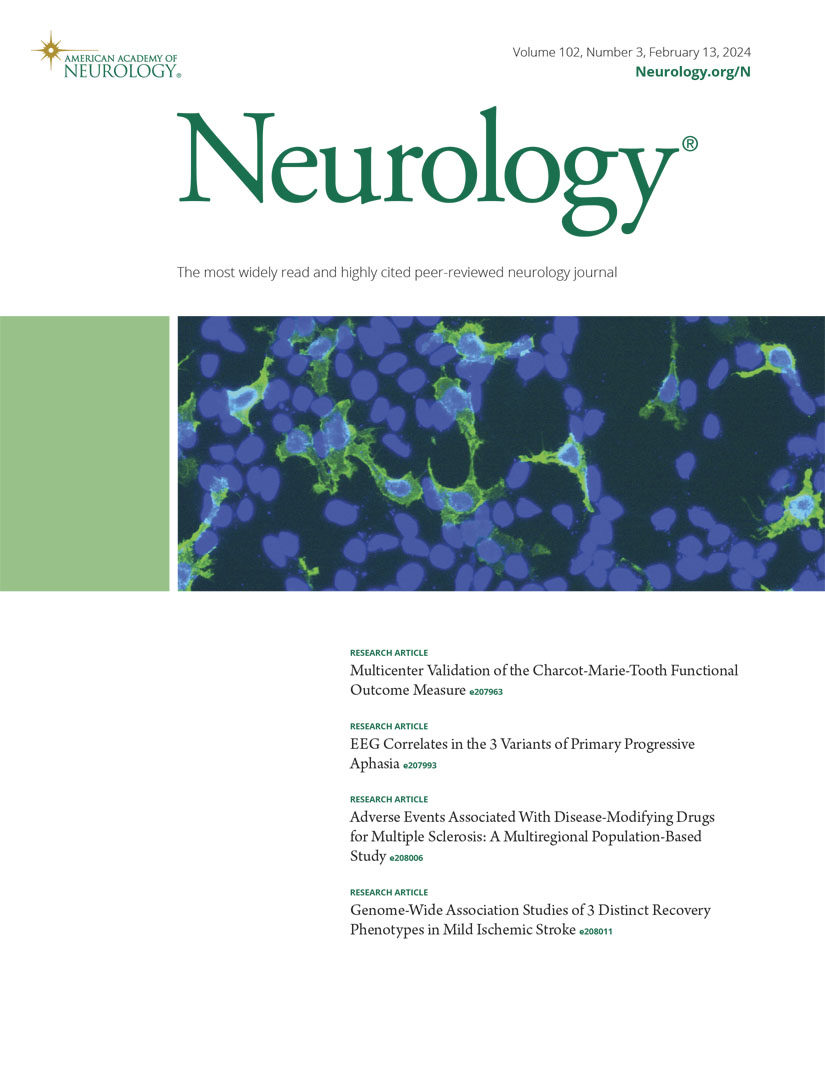降低双生脊髓性肌萎缩症患者服用阿巴伐韦前存在的AAV9抗体滴度
IF 7.7
1区 医学
Q1 CLINICAL NEUROLOGY
引用次数: 0
摘要
目的:对腺相关病毒(aav)预先存在的免疫是获得基因治疗资格的主要障碍。方法在脊髓性肌萎缩症(SMA)基因治疗前,采用血浆置换联合利妥昔单抗降低抗aav9抗体(AAV Ab)滴度的可行性。结果6例21月龄SMA患儿AAV9抗体滴度为1:80,超过了接受OA治疗的1:50标准。由于自发降低抗体滴度的预期较低,他们接受了11次血浆交换和2剂利妥昔单抗,导致他们的AAV9抗体滴度下降到OA的合格范围。在OA输注期间,尽管进行了甲基强的松龙预处理,但这对双胞胎都出现了以荨麻疹、喘息和胃肠道紊乱为特征的急性超敏反应,这些反应通过肾上腺素缓解。他们接受的有限剂量OA没有导致明显的临床改善。讨论:治疗性血浆交换和利妥昔单抗成功地将AAV抗体滴度降低到符合条件的范围,但该方案与皮质类固醇联合使用不足以防止预先存在AAV抗体的患者对AAV基因治疗的输注反应。需要进一步的研究来确定一个方案,使患者能够在预先存在免疫的情况下接受基于AAV的基因治疗。本文章由计算机程序翻译,如有差异,请以英文原文为准。
Reduction of Preexisting AAV9 Antibody Titers Before Onasemnogene Abeparvovec Administration in Twins With Spinal Muscular Atrophy.
OBJECTIVES
Preexisting immunity to adeno-associated viruses (AAVs) presents a major obstacle to eligibility for gene therapy.
METHODS
We determined the feasibility of immunodepletion with therapeutic plasma exchange and rituximab to lower anti-AAV9 antibody (AAV Ab) titers before gene therapy for spinal muscular atrophy (SMA).
RESULTS
Twin 21-month-old brothers with SMA presented with AAV9 Ab titers of 1:800, exceeding the limit of 1:50 for eligibility to receive onasemnogene abeparvovec (OA). Because there was a low expectation of spontaneous reduction in Ab titers, they received 11 plasma exchanges and 2 doses of rituximab, leading to their AAV9 Ab titers dropping to the eligibility range for OA. During their OA infusions, despite methylprednisolone pretreatment, both twins experienced acute hypersensitivity reactions characterized by urticaria, wheezing, and GI disturbances that resolved with epinephrine. The limited dose of OA they received did not lead to marked clinical improvement.
DISCUSSION
Therapeutic plasma exchange and rituximab successfully reduced the AAV Ab titers to the range of eligibility, but this regimen combined with corticosteroids was not sufficient to prevent infusion reactions to AAV gene therapy in our patients with preexisting AAV Abs. Further studies are needed to define a protocol that could enable patients to receive AAV-based gene therapy in the presence of preexisting immunity.
求助全文
通过发布文献求助,成功后即可免费获取论文全文。
去求助
来源期刊

Neurology
医学-临床神经学
CiteScore
12.20
自引率
4.00%
发文量
1973
审稿时长
2-3 weeks
期刊介绍:
Neurology, the official journal of the American Academy of Neurology, aspires to be the premier peer-reviewed journal for clinical neurology research. Its mission is to publish exceptional peer-reviewed original research articles, editorials, and reviews to improve patient care, education, clinical research, and professionalism in neurology.
As the leading clinical neurology journal worldwide, Neurology targets physicians specializing in nervous system diseases and conditions. It aims to advance the field by presenting new basic and clinical research that influences neurological practice. The journal is a leading source of cutting-edge, peer-reviewed information for the neurology community worldwide. Editorial content includes Research, Clinical/Scientific Notes, Views, Historical Neurology, NeuroImages, Humanities, Letters, and position papers from the American Academy of Neurology. The online version is considered the definitive version, encompassing all available content.
Neurology is indexed in prestigious databases such as MEDLINE/PubMed, Embase, Scopus, Biological Abstracts®, PsycINFO®, Current Contents®, Web of Science®, CrossRef, and Google Scholar.
 求助内容:
求助内容: 应助结果提醒方式:
应助结果提醒方式:


